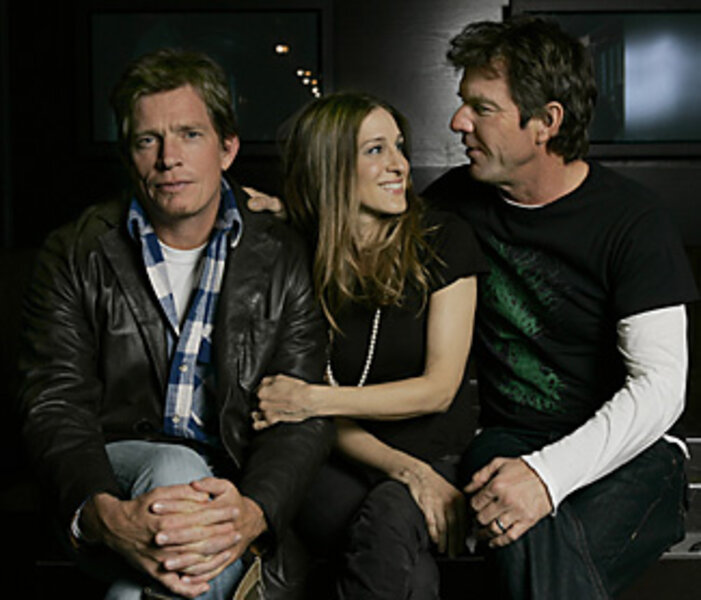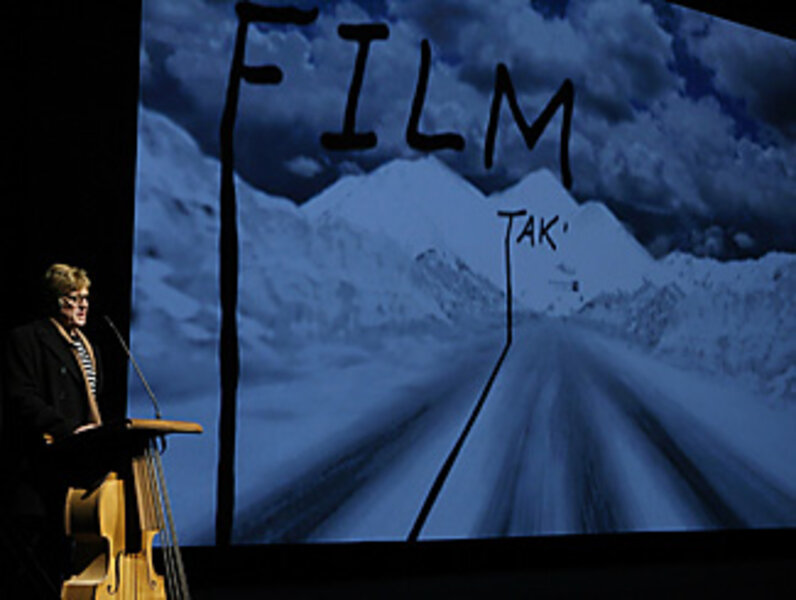At Sundance, the big draws are Patti Smith, U2, Roman Polanski, Osama bin Laden
| Park City, Utah
At the opening night for the 2008 Sundance Film Festival, founding director Robert Redford mentioned "change," and the audience let out a collective groan. The most overused word of the political season was poised to become the buzzword for America's most renowned film festival.
But Redford quickly recovered. "We've heard that word being used ad nauseam," he said, "but artists really are agents of change. They're the first responders. They document change as it's occurring in the world around us."
Another type of change at Sundance is the ka-ching kind. Despite its purer-than-the-driven-(Utah)-snow mission to be the premier showplace for independent film – both home grown and, increasingly, foreign – Sundance is also a vast sellers' market where the deal often obscures the movie. In other words, it's a microcosm – a snow globe – of the movie business itself, where art and commerce are forever locked in an uneasy embrace.
And I haven't even mentioned the swag lounges – the city granted 50 more permits than last year to company-sponsored lounges, an alarming uptick in what is often referred to as "Brand-dance."
Braving the bitter cold were bottled-water swigging swarms of bundled-up buyers and journalists and filmmakers and celebrities – everybody from Colin Farrell to Mos Def to the omnipresent Paris Hilton. It was not unusual to emerge from a screening and be greeted with a spray of rock salt from a passing road crew. My critic's dull pallor – the emblem of a life lived in the dark – fitted in well under the mostly gray Park City skies. There were times when I muttered to myself that this was no country for old critics; Sundance tests your mettle. Just how much do you love movies? The answer from here is: Plenty – enough to slip-slide my way in pursuit of the next masterpiece while encased in outerwear that would give the Abominable Snowman pause.
According to the festival, 2,051 dramatic films and 1,573 documentaries were submitted, of which 121 features – 58 by first-time directors – made the cut. I saw 20 movies in the first six days – the festival runs 10 days – and, as usual, the documentaries were the standouts. I think this is because documentaries, as opposed to fiction films, are usually made by movie-makers who have seized a strong subject and don't expect to get rich off it.
At least that's the theory. Until recently, documentaries were, from a commercial standpoint, on the rise – Michael Moore's movies, "Super Size Me," "Spellbound," "Mad Hot Ballroom," to name just a few, were bonanzas.
But only two of the politically themed Sundance documentaries from last year – "Sicko" and "No End in Sight" – grossed over a million dollars, so this year, from a buyer's perspective, the bloom is off the rose. (Officially this is known as "market skepticism.") But the rose still smells sweet.
The best documentary I saw at Sundance this year was Marina Zenovich's Roman Polanski: Wanted and Desired, an examination of the 1977 case in which the director of "Rosemary's Baby" and "Chinatown" was convicted of unlawful sexual intercourse with a minor and subsequently fled the country to avoid possible jail time. Zenovich has a regrettable penchant for using clips from Polanski's films as a way to explore his psyche, but, drawing on a startling array of archival footage as well as current interviews with the lawyers and the victim – though not Polanski – she lays bare a sordid tragedy of almost Dostoevskian dimensions. (The film was picked up for domestic distribution by HBO.)
Cult rocker Patti Smith showed up for the marvelous documentary about her life – Steven Sebring's Patti Smith: Dream of Life, a lyrical, nonlinear, mostly black-and-white collage that bears a passing resemblance to the Chet Baker doc "Let's Get Lost." In person, as well as on camera, Smith comes off like a cross between Baudelaire and Ophelia, but her trademark monotone, low and insinuating, was nowhere to be heard during the audience Q-and-A; She had an almost schoolgirlish twitter. Smith is an artist of stark dualities: she's fierce and impassive, ravaged and maidenly. I wedged my way into a hush-hush concert she gave in the dungeons of the Sundance House on Main Street, and she delivered a full hour of sonic blast.
Bono had been in Park City, too, where the soon-to-be-released, eye-popping concert film U2 3D was shown. Rumors that he would give a concert proved false. (He apparently wanted to give an outdoor rooftop show; presumably all that jumping around would have kept him warm.) Gonzo: The Life and Work of Dr. Hunter S. Thompson was too hero-worshippy by half, but James Marsh's Man on Wire was a marvel. It's about 24-year-old Philip Petit's daredevil 1974 wire walk between the Twin Towers of the World Trade Center and it's an elegy to both crackpot heroism and the WTC (although Marsh is smart enough to keep 9/11 out of the mix).
Not all the docs were wonderful. Morgan Spurlock's Where in the World Is Osama Bin Laden? was a jokey movie about terrorism. (The rumor that Spurlock had scored an on-camera interview with bin Laden was – big surprise – erroneous.)
Nanette Burstein's highly touted American Teen, which follows four Indiana teenagers through their senior year, was too reality TV-ish and offered up the shocker that kids today – at least white, middle-class Midwestern kids – are really mixed up.
I am focusing on the docs because the dramatic features this year, by common consent, where weak. A major distributor took me aside after a screening and spoke for everyone when he wailed, "Give me sustenance!" (As with everyone else, I missed a few highly regarded candidates, including, in my case, Ballast and The Frozen River.)
Christine Jeff's Sunshine Cleaners, the first film to sell out the festival, has that all important Sundance word "sunshine" in its title; it even has in its cast, à la "Little Miss Sunshine," Alan Arkin. But this comedy about two sisters who go into business cleaning up blood-soaked crime scenes is notable mostly for Amy Adams's full-scale performance. Amy Adams is the official It Girl of Sundance.
August stars Josh Hartnett as a pre-9/11 dotcom entrepreneur whose bubble has burst – not the freshest of subjects. The fitfully amusing Smart People stars Dennis Quaid as a grouchy college lit professor, and it's like a second-string "Wonder Boys."
Jonathan Levine's The Wackness is about a pot-dealing slacker, played by Josh Peck, who bonds with his pot-smoking psychiatrist, played by Ben Kingsley in full gaga mode. This is the sort of movie that convinces me yet again that a Sundance computer program exists somewhere out there. Call up "angst," go to "quirky," and then click on "dysfunctional."
But there is always the dim but real possibility that some quirky, angst-ridden movie about dysfunctional characters will turn out to be a charmer. It's enough to keep us trudging through the snowdrifts.









